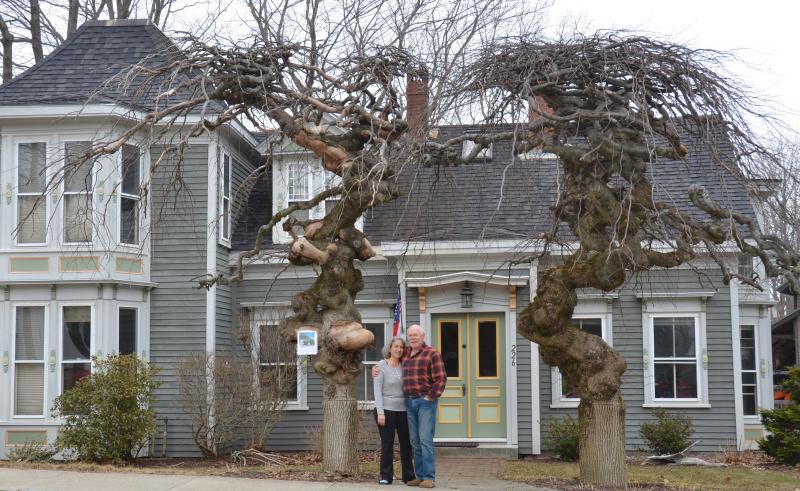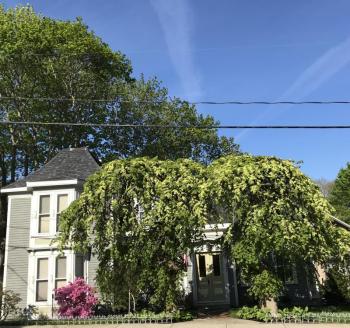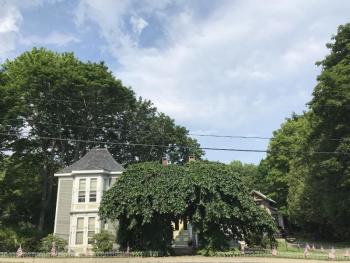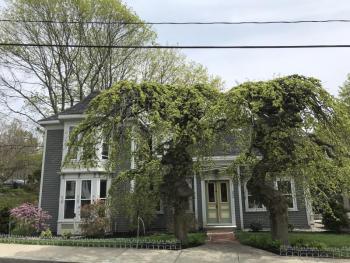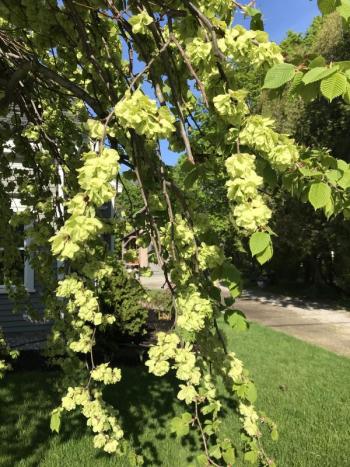Two much-loved Rockport Camperdown Elms succumb to disease
ROCKPORT — The two trees have maintained an aesthetic presence in Rockport Village for almost 100 years, a flourish in an often austere New England landscape. But, one has died, and its mate is now on its last legs; both suffering the ravages of Dutch Elm Disease, a fungus that infested them via beetles, taking a fatal toll.
“We tried everything,” said Haunani Wallace, who, along with her husband, Doc, bought the home and property almost three years ago, in large part because of the trees.
They are Camperdown (Ulmus glabra 'Camperdownii) Elms, an unusual tree in Maine’s Midcoast, nurtured here by grafting a tree with lineage back to Scotland onto an American Elm. There are several in the area, likely planted around 1930, and are thought to have originated at a nursery that was once on Union Street in Camden.
Two Camperdown Elms are at an entrance to the Camden Amphitheatre, and more at Norumbega, on Route 1.
But the Rockport Camperdowns get significant visibility, as they have graced the front entrance of a Union Street home, across from the post office, for close to a century.
“They were happy for a long time and something changed,” said Aaron Bergdahl, forest pathologist for the Maine Dept. of Agriculture, Conservation and Forestry. “Or it was just bad luck. An insect happened to stop by. Once a tree gets Dutch Elm there’s nothing you can do to cure it.”
While an elm can be treated with injections, the disease will always be present.
For these two Camperdowns, the affliction was noticed more than two years, and showed symptoms after the Wallaces purchased their Rockport Village home in 2017. The Wallaces had been looking for a year-round home in Rockport after renting seasonally.
“This was the only house we looked at and we fell in love with it,” said Haunani. “The trees were magnificent.”
At first, it was thought to be a canopy trouble.
“In Summer 2018, the trees were quite healthy but the north tree was starting to show some signs of stress,” said Haunani Wallace.
They contacted aborists, and in Spring 2019, there was yet to be a diagnosis. The tree on the north side of the property was first to suffer.
“The south tree looked magnificent,” she said. “One week later, it was brown.”
Insects were suspected, and tree samples were sent to the Maine state entomologist. The tree was sprayed, but, “from there it was all down hill,” said Haunani.
Bergdahl said he diagnosed the problem as Dutch Elm disease, a fungus scourge that is spread via beetles. It destroyed millions of the graceful American Elms across the country over the middle of the last century.
The Rockport diagnosis was confirmed by two separate UMaine lab tests, he said. In the lab, the fungus was grown in sterile conditions.
“It survives, grows and gets a specific structure,” said Bergdahl. “You can look at spores and be very certain it’s Dutch Elm.”
In this case, it was a “pretty robust confirmation,” identifying Dutch Elm disease.
“There are several things that cause an elm branch to wilt — an insect or pruning injury, or chemical exposure,” he said. “There are lots of possibilities, so you want to confirm the causal agent.”
“The symptoms matched several signs,” he added.
While elms are prolific across the country, the Camperdown is not. But, he said, the Camperdown is more resistant to the Dutch Elm disease.
“If an elm is super healthy, beetles will not be attracted to it,” he said. “It is hard for larvae to be successful.”
What introduces stress to a tree, these two in particular?
“My thought, all speculative, perhaps were long summer droughts, which could have attracted a beetle to the trees,” he said.
For the Wallaces, the diagnosis lead to hard decisions.
The advice was forthright: “Unfortunately, while preventative injections have been used successfully in many areas for many years, I am not aware of any proven curative fungicide injections (that is, once a tree has the disease, one cannot rid the tree of disease),” wrote Bergdahl, last September. “Aside from that, injections are not as effective this time of year due to the physiology of the tree heading into fall – most injections are done in the spring/early summer for best uptake and distribution of product. Further, injection would not save/cure tree parts already blighted by the fungus, so heavy pruning would need to be involved, which would likely ruin the aesthetics of the tree. If you are not concerned about spending the money on a treatment that very likely will not work, you could try it as a last resort, but the scientific work done on Dutch Elm disease does not support a positive outcome. Sorry to be pessimistic about this, but I have a lot of experience working with elms and Dutch elm disease and I am afraid your trees will not make it.”
Earlier this month, after watching the branch get more brittle and break, they decided it was time to fell the trees.
They intend to save some of the wood for furniture, “a dining table, long and narrow,” said Haunani.
And, they are offering parts of the trees to artists, “to turn them into art.”
Reach Editorial Director Lynda Clancy at lyndaclancy@penbaypilot.com; 207-706-6657


